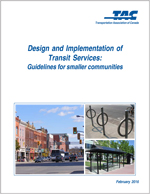Design and Implementation of Transit Services provides advice and guidance to planning and transportation professionals in planning for transit services in small communities. The guidelines were developed to tailor to a wide range of different stages of transit service provision in the community:
- starting a new service
- expanding an existing service
- maintaining a service in potential decline
The guidelines include planning directions and technical approaches to effectively plan and design services, as well as to develop transit policies that promote cost effectiveness, maximize ridership, and respond to the needs of small and rural communities. The document outlines specific transit planning activities and topics including: consultation; Service needs and objectives identification; service planning; demand forecasting; resource planning; governance; financial planning; service implementation; and service monitoring.
Background: Transit plays an essential role in improving the social, economic, and environmental conditions of Canada’s cities and communities. While there is greater political attention to serving transit needs in larger urban areas, transit services are increasingly vital to improving the well-being of small communities. Providing transit services will become increasingly important in small communities as a result of an increasing aging population, the continued transition to a knowledge economy, the increasing cost of vehicle ownership, and the increasing environmental impacts from atmospheric pollutants.
There are unique challenges faced by small and rural Canadian communities in providing transit services, compared to large, more urban areas. The approaches to planning for transit and the range of solutions appropriate for providing transit is broader for small communities compared to larger urban centres.
Disponible en français : Conception et mise en oeuvre de services de transports en commun : Lignes directrices à l’intention des petites collectivités (2016)


